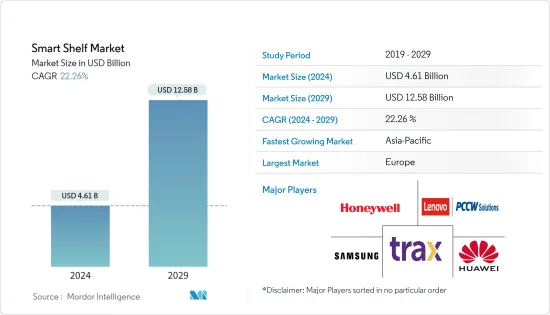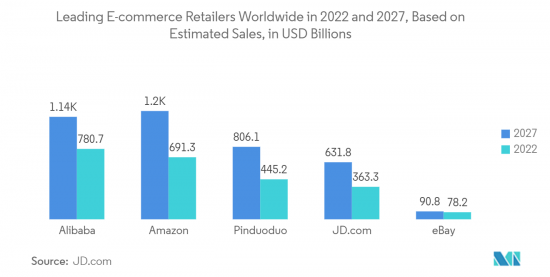 |
市场调查报告书
商品编码
1408016
智慧货架 -市场占有率分析、产业趋势/统计、2024-2029 年成长预测Smart Shelf - Market Share Analysis, Industry Trends & Statistics, Growth Forecasts 2024 - 2029 |
||||||
※ 本网页内容可能与最新版本有所差异。详细情况请与我们联繫。
智慧货架市场规模预计到2024年为46.1亿美元,预计到2029年将达到125.8亿美元,在预测期内(2024-2029年)复合年增长率为22.26%。

智慧货架是零售商店中用于追踪库存的电子连接货架。智慧货架结合数位显示器、RFID 标籤和感测器来提供详细的产品资讯、交叉销售建议和行销。它还为零售商提供了有关客户购物模式和偏好的宝贵见解。
主要亮点
- 推动智慧货架市场的关键原因是零售商改善库存管理以提供更智慧的补货选项和即时参与,以及零售商使用智慧和自动化技术为客户提供更好的购物体验。
- 由于都市化和消费者购买力的增强,对天然材料和优质产品不断增长的需求正在推动市场开拓。零售自动化越来越普及,零售商强烈要求透过定价优化和即时产品投放来提高销售效率。这些只是推动全球市场兴奋的一些主要因素。
- 电商平台销售额快速成长。这一发展为电子商务仓库提供了有效库存管理的新产品,为调查行业的蓬勃发展提供了机会。根据美国人口普查局数据,2022年7月至9月美国商业电商规模约2,660亿美元,较上季成长3%。此外,零售额的增加也推动了该产业的发展。
- 当顾客离开商店时,RFID 追踪不会停止。当顾客使用信用卡或签帐金融卡或在结帐时扫描忠诚折扣卡时,零售商可以将购买历史记录与 RFID资料连结起来,并使用该资讯来追踪各个顾客在商店中的行程。您可以绘製途径或整个购物中心的地图。这显示RFID损害了用户的隐私,是市场成长的障碍。
- COVID-19 之后,随着零售商寻求利用先进技术的优势来改善库存管理和优化供应链,预计超市货架市场的成长将加速。随着电子商务的兴起和消费行为的变化,零售商正在寻找创新的方法来改善店内体验并提高客户忠诚度。
智慧货架市场趋势
采用强化库存管理预计将推动市场发展
- 随着线上销售的成长,企业必须以合理的价格投资于一系列始终如一的高品质产品。在这种新情况下,管理安全库存和优化业务效率比以往任何时候都更加重要。因此,电子商务企业近年来增加了库存管理软体的使用。世界各地的零售企业都需要库存管理系统来追踪现有库存并满足不断增长的需求。
- 零售公司正在寻找更好、更省时且更具成本效益的库存管理方法。传统的库存管理系统既耗时又容易出现人为错误,为企业带来时间和金钱的损失。零售商可以利用智慧货架、自主库存机器人和 RFID 等智慧库存管理技术,最大限度地减少损耗并提高企业整体效率。
- 自主库存机器人、智慧货架和RFID等智慧库存管理技术正在帮助零售商提高业务效率并减少损失。
- 此外,智慧库存管理 (SIM) 的广泛采用有助于最大限度地减少开支,并利用资料和软体以最少的库存满足不断增长的消费者需求,从而推动成长。这很有帮助。资料提供更深入的洞察来预测需求并提高效率,而自动化技术则同步多个销售管道的库存,以最大限度地提高收益。

欧洲占主要市场占有率
- 英国是全球智慧货架市场最重要的地区之一。该地区的主要需求来源包括零售、物流和医疗保健行业。该地区的智慧货架市场见证了多次重大合併,各个主要参与者都将其作为改善业务、接触客户和增加影响力以满足各种应用要求的策略的一部分。
- 欧洲零售商,尤其是德国,是世界上最早采用电子货架标籤(ESL)来降低营运成本的零售商之一,作为零售数位化的基础。 2022年5月,德国数位解决方案供应商汉朔在同周举办的“EuroCIS 2022”展览会上宣布并推出了全新物联网平台“All Star”,该平台将用于实体店和零售店。- 欧洲砂浆零售,有望引领产业进入效率和盈利的新时代。
- 此外,2022年5月,快速发展的德国电子货架标籤公司Digety与能源采集专家Nowi合作,开发了用于零售商店的太阳能电子货架标籤。此次合作的主要目的是满足不断增长的市场需求,提供创新的解决方案,使零售商能够最大限度地提高产量比率并更有效地管理整个供应链流程。Masu。
- 在全球智慧货架市场中,义大利在欧洲国家中呈现出引人注目的成长速度。这主要是由于全部区域主要企业的存在以及电子货架标籤的高普及。
- 随着零售商越来越多地采用智慧货架技术来改善业务和改善客户体验,法国智慧货架市场正在快速成长。在法国,家乐福、欧尚和卡西诺等主要零售商已经在一些商店引入了智慧货架,其他商店也可能会效仿。法国智慧货架市场由多种因素推动,包括对即时库存管理不断增长的需求以及零售商优化业务和消除浪费的需求。
- 由于零售量的增加以及各连锁超级市场越来越多地采用智慧货架,欧洲对智慧货架的需求预计将增加。
智慧货架产业概况
由于多家全球公司的存在,智慧货架市场竞争非常激烈。主要企业包括艾利丹尼森公司、AWM智慧货架、华为技术有限公司、Dreamztech Solutions Inc.、E Ink Holdings Inc.、Focal Systems Inc.和Happiest Minds Technologies Limited。该市场的主要企业正在推出创新的新产品并建立伙伴关係和协作,以获得竞争优势。
- 2022 年 5 月 - 艾利丹尼森公司宣布两项总计 4500 万欧元的重大投资,用于扩大欧洲的製造能力并提高工厂效率,以满足对标籤和包装材料不断增长的需求(4821 万美元)。
- 2022 年 5 月 - 艾利丹尼森公司与物联网先驱 Wiliot 合作,将物联网扩展到新的水平,创造造福人类和地球的物联网新时代。艾利丹尼森将利用其研发能力和规模来设计和製造第二代 Wiliot 标籤,这是一款配备蓝牙的邮票大小的电脑。
其他福利:
- Excel 格式的市场预测 (ME) 表
- 3 个月的分析师支持
目录
第一章简介
- 研究假设和市场定义
- 调查范围
第二章调查方法
第三章执行摘要
第四章市场洞察
- 市场概况
- 产业吸引力-波特五力分析
- 供应商的议价能力
- 消费者议价能力
- 新进入者的威胁
- 替代品的威胁
- 竞争公司之间敌对关係的强度
- 产业价值链分析
- COVID-19 市场影响评估
第五章市场动态
- 市场驱动因素
- 采用强化库存管理
- 零售业对即时库存资讯和库存管理的需求不断增长
- 市场挑战
- 关于内建资料标籤的隐私问题
第六章市场区隔
- 按成分
- 硬体
- 物联网感测器
- RFID 标籤和阅读器
- 电子货架标籤 (ESL)
- 相机
- 软体
- 服务
- 硬体
- 按用途
- 库存控制
- 价格管理
- 内容管理
- 货架图管理
- 其他的
- 按地区
- 北美洲
- 美国
- 加拿大
- 欧洲
- 英国
- 德国
- 义大利
- 法国
- 欧洲其他地区
- 亚太地区
- 中国
- 印度
- 日本
- 韩国
- 澳洲和纽西兰
- 其他亚太地区
- 拉丁美洲
- 巴西
- 墨西哥
- 其他拉丁美洲
- 中东/非洲
- 北美洲
第七章 竞争形势
- 公司简介
- Honeywell International Inc.
- Huawei Technologies Co. Ltd
- Trax Technology Solutions
- Lenovo PCCW Solutions Limited
- Samsung Electronics Co. Ltd
- AWM Smart Shelf
- Happiest Minds Technologies Limited
- E Ink Holdings Inc.
- Avery Dennison Corporation
- Intel Corporation
- NXP Semiconductors NV
第八章投资分析
第9章市场的未来

The Smart Shelf Market size is estimated at USD 4.61 billion in 2024, and is expected to reach USD 12.58 billion by 2029, growing at a CAGR of 22.26% during the forecast period (2024-2029).
Smart shelves are electronically connected shelves used in retail outlets to track inventory. Smart shelves use a combination of digital displays, RFID tags, and sensors to provide detailed product information, cross-selling recommendations, and marketing. They also provide retailers with valuable insights into customer shopping patterns and preferences.
Key Highlights
- The primary reasons driving the Smart Shelf Market are the commission of improved inventory management by retail to make smarter restocking options and real-time involvement, as well as the use of intelligence and automation technologies by retail to provide a better shopping experience for customers.
- Rising demand for natural and premium products promotes market development due to increased urbanization and consumer buying power. Retail automation is growing more popular, and there is a strong demand among retailers for pricing optimization and enhanced operating effectiveness with real-time product placement. These are only a few of the major factors fueling the market's global rise.
- E-commerce platform sales are rapidly increasing; this development provides a chance for the researched industry to flourish by giving new items to e-commerce warehouses to manage effective inventory management. According to the US Census Bureau, commercial e-commerce in the United States was about USD 266 billion from July to September 2022, a 3% increase over the past quarter. Furthermore, rising retail sales is also propelling the industry.
- RFID tracking does not stop when a customer leaves the store. If customers pay with a credit or debit card or scan a loyalty discount card at checkout, retailers may link the purchases to the RFID data and use the information to map out individual customers' travels around the store, or even an entire shopping complex. This indicates it is harming the user's privacy, which acts as an obstacle to the growth of the market.
- Post-COVID-19, the mart shelves market is expected to grow faster as retailers seek to leverage advanced technologies' benefits to improve inventory management and optimize their supply chain. With the rise of e-commerce and changing consumer behavior, retailers are looking for innovative ways to enhance the in-store experience and increase customer loyalty.
Smart Shelf Market Trends
Adoption of Enhanced Inventory Management is Expected to Drive the Market
- With increasing online sales, it is important for businesses to invest in a robust pipeline of fairly priced, consistent, and high-quality goods. In this new context, managing safety inventories and optimizing operational efficiency is more important than ever. As a result, e-commerce businesses have increased their usage of inventory management software in recent years. Inventory management systems are required by retail companies all around the globe to assist them in keeping track of their existing inventory and meet escalating demand.
- Retailers are seeking better, more time-efficient, and cost-effective inventory management methods. Traditional inventory management systems are time-consuming and prone to human mistakes, both of which cost firms time and money. Retailers can minimize shrinkage and enhance overall company efficiency by using smart inventory management technologies, such as smart shelves, autonomous inventory robots, RFID, and so on.
- Smart inventory management methods, such as autonomous inventory robots, smart shelves, and RFID, are assisting retailers in becoming more operationally effective and reducing loss.
- Additionally, this increased adoption of Smart Inventory Management (SIM) helps to minimize expenses and drive growth by utilizing data and software to assist in meeting rising consumer demand with the least amount of inventory. Data provides greater insight, allowing to estimate demand and enhance efficiency, while automated technology synchronizes the inventory across numerous sales channels, maximizing revenues.

Europe Holds Significant Market Share
- The United Kingdom is one of the most significant regions in the global smart shelf market. The major sources of demand in the region include the retail, logistics, and healthcare sectors. The smart shelf market within the region is witnessing various several significant mergers, acquisitions, and investments by the key major players as part of its strategy to improve business and their presence to reach customers and meet their requirements for various applications.
- European retailers, especially Germany, are some of the world's earliest adopters of electronic shelf labels (ESLs) to reduce operations costs as a foundation for retail digitalization. In May 2022, at the week's EuroCIS 2022 trade show, the new IoT platform All-Star was released and introduced by the digital solutions provider Hanshow, with operations in Germany, which is expected to drive Europe's brickandmortar retail into a new era of efficiency and profitability.
- Also, in May 2022, Digety, a fast-growing electronic shelf label company from Germany, partnered with Nowi, which specializes in energy harvesting, to develop solar-powered electronic shelf labels used in retail stores. This collaboration primarily aims to meet the surging market demand to offer retail stores an innovative solution that would further enable them to maximize their yield and manage their overall supply chain processes more effectively.
- Italy has a significant growth rate in the global smart shelf market among the various European countries. It is mainly due to the presence of key major players as well as a higher penetration rate of electronic shelf labels within the entire region.
- The smart shelves market in France is growing rapidly as retailers increasingly adopt smart shelf technology to improve their operations and enhance the customer experience. In France, major retailers such as Carrefour, Auchan, and Casino have already implemented smart shelves in some of their stores, with others likely to follow suit. The market for smart shelves in France is being driven by several factors, including the increasing demand for real-time inventory management and the need for retailers to optimize their operations and reduce waste.
- The growing retail sales volume, along with the rising adoption of smart shelves in various chains of supermarkets, is expected to increase the demand for smart shelves in Europe.
Smart Shelf Industry Overview
The Smart Shelf Market is competitive in nature because of the presence of several global companies. Some of the key players are Avery Dennison Corporation, AWM Smart Shelf, Huawei Technologies Co. Ltd, Dreamztech Solutions Inc., E Ink Holdings Inc., Focal Systems Inc., Happiest Minds Technologies Limited, and many others. Key players in this market are introducing new innovative products and forming partnerships and collaborations to gain competitive advantages.
- May 2022 - Avery Dennison Corporation announced two major investments for expanding its manufacturing capacity and improving factory efficiency in Europe to meet the growing demand for its label and packaging materials, with an investment of EUR 45 million (USD 48.21 million).
- May 2022 - Avery Dennison Corporation and Wiliot, the Internet of Things pioneer, partnered to scale the IoT to the next level, creating a new era of IoT that benefits people and the planet. Avery Dennison would leverage its R&D capabilities and scale to design and manufacture second-generation Wiliot tags, which are stamp-sized computers powered by Bluetooth.
Additional Benefits:
- The market estimate (ME) sheet in Excel format
- 3 months of analyst support
TABLE OF CONTENTS
1 INTRODUCTION
- 1.1 Study Assumptions and Market Definition
- 1.2 Scope of the Study
2 RESEARCH METHODOLOGY
3 EXECUTIVE SUMMARY
4 MARKET INSIGHTS
- 4.1 Market Overview
- 4.2 Industry Attractiveness - Porter's Five Forces Analysis
- 4.2.1 Bargaining Power of Suppliers
- 4.2.2 Bargaining Power of Consumers
- 4.2.3 Threat of New Entrants
- 4.2.4 Threat of Substitute Products
- 4.2.5 Intensity of Competitive Rivalry
- 4.3 Industry Value Chain Analysis
- 4.4 Assessment of Impact of COVID-19 on the Market
5 MARKET DYNAMICS
- 5.1 Market Drivers
- 5.1.1 Adoption of Enhanced Inventory Management
- 5.1.2 Growing Demand for Real-Time Stock Information and Inventory Management in the Retail Sector
- 5.2 Market Challenges
- 5.2.1 Privacy Concerns Regarding Inbuilt Data Tags
6 MARKET SEGMENTATION
- 6.1 By Component
- 6.1.1 Hardware
- 6.1.1.1 IoT Sensors
- 6.1.1.2 RFID Tags and Readers
- 6.1.1.3 Electronic Shelf Lables (ESL)
- 6.1.1.4 Cameras
- 6.1.2 Software
- 6.1.3 Service
- 6.1.1 Hardware
- 6.2 By Application
- 6.2.1 Inventory Management
- 6.2.2 Pricing Management
- 6.2.3 Content Management
- 6.2.4 Planogram Management
- 6.2.5 Other Applications
- 6.3 By Geography
- 6.3.1 North America
- 6.3.1.1 United States
- 6.3.1.2 Canada
- 6.3.2 Europe
- 6.3.2.1 United Kingdom
- 6.3.2.2 Germany
- 6.3.2.3 Italy
- 6.3.2.4 France
- 6.3.2.5 Rest of the Europe
- 6.3.3 Asia Pacific
- 6.3.3.1 China
- 6.3.3.2 India
- 6.3.3.3 Japan
- 6.3.3.4 South Korea
- 6.3.3.5 Australia and New Zealand
- 6.3.3.6 Rest of the Asia Pacific
- 6.3.4 Latin America
- 6.3.4.1 Brazil
- 6.3.4.2 Mexico
- 6.3.4.3 Rest of the Latin America
- 6.3.5 Middle East and Africa
- 6.3.1 North America
7 COMPETITIVE LANDSCAPE
- 7.1 Company Profiles
- 7.1.1 Honeywell International Inc.
- 7.1.2 Huawei Technologies Co. Ltd
- 7.1.3 Trax Technology Solutions
- 7.1.4 Lenovo PCCW Solutions Limited
- 7.1.5 Samsung Electronics Co. Ltd
- 7.1.6 AWM Smart Shelf
- 7.1.7 Happiest Minds Technologies Limited
- 7.1.8 E Ink Holdings Inc.
- 7.1.9 Avery Dennison Corporation
- 7.1.10 Intel Corporation
- 7.1.11 NXP Semiconductors NV










